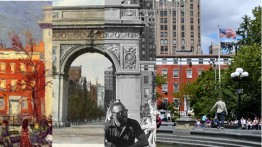The City Transformed: Part I

The City Transformed: Part I
Cost: $300.00
This series of eight slide lectures illustrates the historic transformations of New York City. Discover how architectural and engineering innovations—along with human ingenuity—transformed New York into a world-class metropolis.
Barry Lewis’ walking tours of Broadway, 42nd Street, Brooklyn and Harlem, with host David Hartman, were nationally televised on public television. His Broadway walking tour was given 3 ½ stars by The Daily News and was highlighted in The New York Times and TV Guide. Of the series, The New York Post said “…. only Lewis could do it.”
*Students may only register for this class as a full eight-session course.
Lecture 1 - New York Before the Modern Era, 1620s–1830
Colonial and early American: New York evolves from a small village to the “nation’s capital,” culminating in the Federal style of 1783-1830.
Lecture 2 - The Greek Revival, 1830–1845
The new industrial metropolis, fed by canals, railroads and immigrants, frames its architecture in the first “modernism” inspired by the ancient Greek temple.
Lecture 3 - The Neo-Gothic and the Italianate, 1845–1870
Eclectic styles allow this burgeoning “capital” city to create the modern buildings we needed: from Italianate grand department stores to suburban neo-Gothic villas.
Lecture 4 - The Cast-Iron Era, 1845–1870
The first modular system of architecture allows us to create the Lever Houses and Seagram Buildings of the 19th century.
Lecture 5 - The “El” Trains and the Brooklyn Bridge, 1869–1890
The Interstates of their day, the el trains and the Brooklyn Bridge allowed this city of one million, and its sister city of Brooklyn, to open rural lands to urban development.
Lecture 6 - Central Park and City Planning, 1857–1900
The parks (Central and Prospect), the parkways (Eastern and Ocean) and the garden suburbs (Richmond Hill, Prospect Park South, etc.) civilized the new metropolises—New York and Brooklyn—created by the el trains and the Brooklyn Bridge.
Lecture 7 - The post-Civil War Era, 1865–1885
In its first stirrings as a “world capital” New York puts up neo-Baroque department stores in the Ladies’ Mile and chateaux on Fifth Avenue while neo-Grec cast-iron industrial buildings and Ruskinian Gothic civic buildings auger a new aesthetic for the next century.
Lecture 8 - The Arts and Crafts Era, 1880–90
Respect for materials and structure creates a modern sensibility, whether in functionalist neo-Romanesque commercial buildings, early skyscraper-style corporate headquarters or charming arts and crafts houses from the Upper West Side to Bedford-Stuyvesant.
Additional Information
Students may only register for this class as a full eight-session course.
REGISTER HERE
Course Code: 117608
Instructor(s): Barry Lewis




